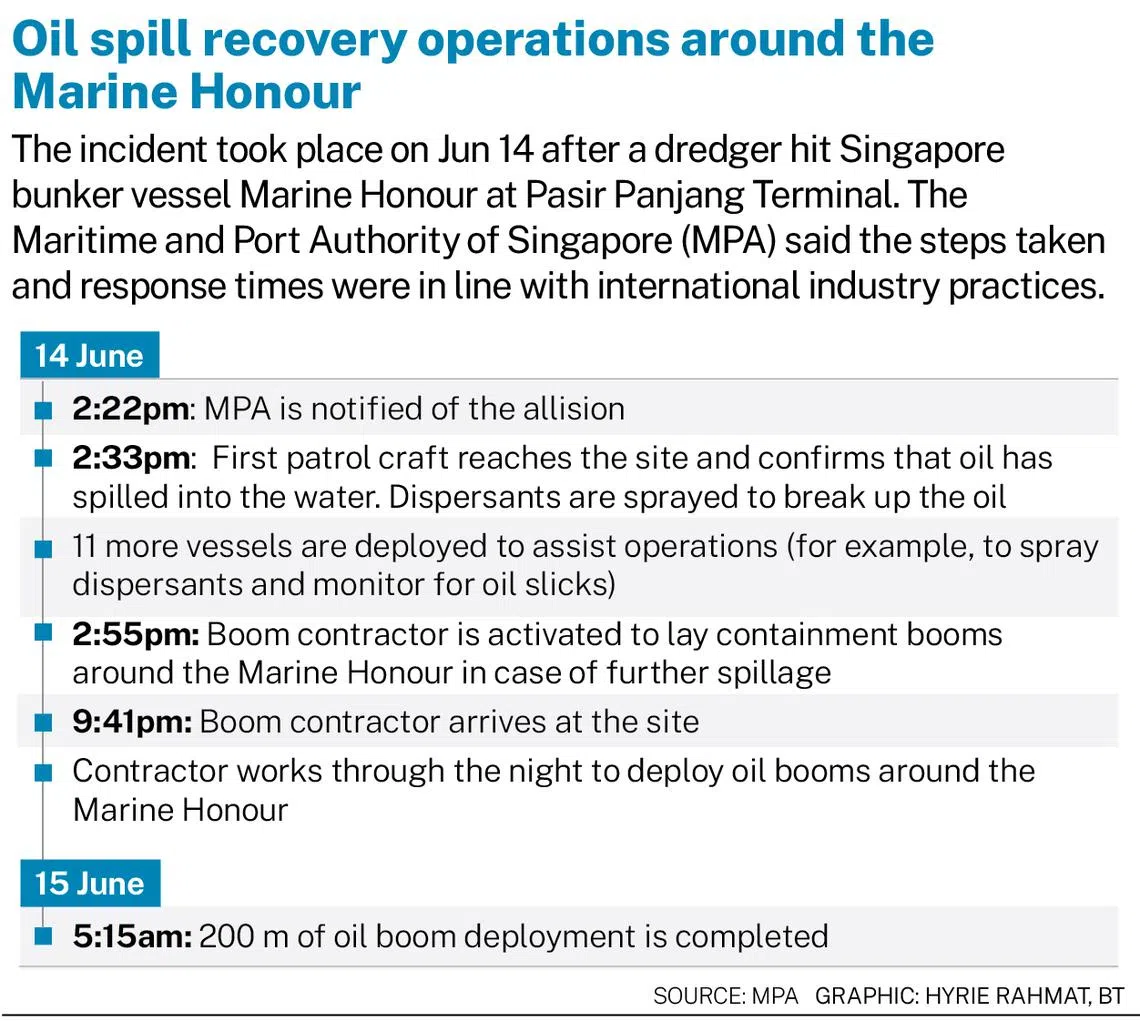Singapore monitoring impact of oil spill on beach-front businesses: Grace Fu
The Republic has made ‘good progress’ in the cleanup efforts, and will move into the second phase of recovery operations

SINGAPORE is monitoring the impact of the recent oil spill on beach-front businesses which operate sea-based activities, said Minister for Sustainability and the Environment Grace Fu on Monday (Jun 24).
“We are aware that businesses operating sea-based activities in the affected areas have been directly affected,” she said at a press conference on Singapore’s response to the spill.
She noted that two types of business have been hit: those which run operations on the water, such as kayak rental shops, and businesses affected because of the “perception about the smell and the oil spill”.
Businesses in the former group will not be able to resume operations until the cleanup is done, she said. For those in the second group, Fu noted, visitor confidence has returned as the recovery efforts made progress.
“In fact, I was there on Saturday and found that Singaporeans were back, and were barbecuing along the beach front,” she said.
Yet, as the situation evolves, the agencies will continue to monitor the impact on the affected businesses, she said.
“We seek the understanding of members of the public and businesses affected by this incident, as we need time to recover safely.”
‘Good progress’ made
The oil spill in the Strait of Singapore was caused by a Netherlands-flagged dredger Vox Maxima hitting Singapore-flagged bunker vessel Marine Honour in Pasir Panjang Terminal on Jun 14.
Following that, oil washed up along Singapore’s coastline, including Sentosa island, East Coast Park and the shoreline of Labrador Nature Reserve.
SEE ALSO
At Monday’s press conference, Fu was joined by Minister for National Development Desmond Lee and Minister for Transport Chee Hong Tat to give an update on the cleanup efforts.
Chee said that “good progress” has been made in dealing with the spill, and that the first phase of the cleanup has largely been completed.
“The removal of bulk oil from the sea and beaches is nearly complete, as we have not seen oil slicks along the East Coast and Changi since Jun 18, based on both satellite and drone images,” he added.
Work now enters the second phase, which entails more focused cleaning of difficult-to-reach areas at sea and on land, the removing of the remaining oil on the damaged Marine Honour, and working with neighbouring countries to mitigate the impact of the spill.
The Maritime and Port Authority of Singapore (MPA) said in a separate statement that this phase will involve specialised resources and equipment, and will be done while considering the conditions at each site – such as wind, tide and currents – to minimise re-pollution of the coastline.
“We are working with oil spill consultants to deploy the most effective methods for cleaning, while minimising cleaning contamination to surrounding areas,” it added.

More than 700 personnel from several government agencies and private organisations have been deployed since the incident for the cleanup efforts, said MPA.
Over 3,400 m of boom – floating partitions used to slow the spread of oil during spills – have been laid to contain trapped oil from flowing back to the sea and to prevent oil remnants from being washed ashore and into inland canals while beach cleanup operations are ongoing.
Recovery timeline
In the next phase, specialised cleanup operations in the more badly hit areas, including Sentosa’s Tanjong and Palawan beaches, are expected to take around three months, based on preliminary estimates, said MPA.
Meanwhile, recovery efforts at the lightly affected areas at Siloso beach in Sentosa, as well as certain stretches of East Coast Park, are expected to be completed earlier.
That said, the situation remains dynamic and “we should be prepared for some uncertainty”, said Fu.
“It is possible for some stranded oil to resurface at a later stage. Oil that has resurfaced in one location can also flow to and affect other areas, carried by wind, current, and the tides,” she said. “This may affect the completion of cleaning. Agencies will continue being vigilant and monitor the situation.”
All beaches on Sentosa remain open; certain stretches of East Coast Park are expected to be progressively reopened as cleanup efforts progress.
But swimming and water activities will resume only after the water quality has returned to normal and is stable, said MPA. Water samples will be collected and tested to ascertain this, and have to remain in the normal range for about a week.
The authorities continued to stress that Singapore’s fish farms have been unaffected by the oil spill and local fish remain safe for consumption. The Republic’s drinking water supply also remains unaffected.
The Singapore Food Agency has been taking fish samples twice daily from coastal fish farms in the East Johor Strait for food safety tests. SFA has also reached out to fish farmers to undertake precautionary measures to protect their farming areas.
The air quality in the affected areas also remains well within safe levels. Nevertheless, the National Environment Agency will continue to monitor the air quality in the affected areas daily to ensure the safety of the public and personnel involved in the cleanup operations.
Decoding Asia newsletter: your guide to navigating Asia in a new global order. Sign up here to get Decoding Asia newsletter. Delivered to your inbox. Free.
Copyright SPH Media. All rights reserved.





